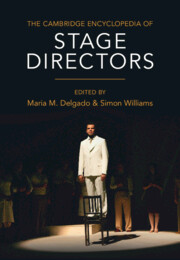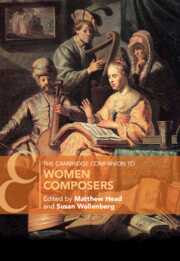Refine search
Actions for selected content:
67 results
8 - Lords of the Mic
- from Part III - Applications of Rap
-
-
- Book:
- The Cambridge Companion to Global Rap
- Published online:
- 25 July 2025
- Print publication:
- 14 August 2025, pp 127-143
-
- Chapter
- Export citation
Chapter 5 - Learning in drama
- from Part 2 - What: the arts learning areas
-
- Book:
- Teaching the Arts
- Published online:
- 28 July 2025
- Print publication:
- 06 August 2025, pp 130-171
-
- Chapter
- Export citation
Chapter 7 - Boulez and Debussy
- from Part II - Musical Modernism
-
-
- Book:
- Boulez in Context
- Published online:
- 08 July 2025
- Print publication:
- 24 July 2025, pp 69-75
-
- Chapter
- Export citation

The Cambridge Encyclopedia of Stage Directors
-
- Published online:
- 19 June 2025
- Print publication:
- 03 July 2025
6 - Making Do and Muddling Through
- from Part II - Migrant Workers Blunting Control
-
- Book:
- Beyond Coercion
- Published online:
- 10 June 2025
- Print publication:
- 12 June 2025, pp 122-145
-
- Chapter
- Export citation
13 - Artists’ Perspectives Experimental and Electronic Music in Australia
- from Part III - Diversities
-
-
- Book:
- The Cambridge Companion to Music in Australia
- Published online:
- 14 November 2024
- Print publication:
- 14 November 2024, pp 205-218
-
- Chapter
- Export citation
15 - Artists’ PerspectivesJazz in Australia – The State of Play
- from Part III - Diversities
-
-
- Book:
- The Cambridge Companion to Music in Australia
- Published online:
- 14 November 2024
- Print publication:
- 14 November 2024, pp 233-242
-
- Chapter
- Export citation
2 - Between Society and Solitude: Schubert’s Improvisations
- from Part I - The Piano in Schubert’s World
-
-
- Book:
- Schubert's Piano
- Published online:
- 31 August 2024
- Print publication:
- 17 October 2024, pp 30-49
-
- Chapter
- Export citation
8 - Schubert as Balladeer
- from Part III - Sound and Musical Imagery
-
-
- Book:
- Schubert's Piano
- Published online:
- 31 August 2024
- Print publication:
- 17 October 2024, pp 161-179
-
- Chapter
- Export citation
5 - Uncovered Grave
- from Part I - Creative Processes
-
-
- Book:
- The Cambridge Companion to Composition
- Published online:
- 25 May 2024
- Print publication:
- 30 May 2024, pp 77-88
-
- Chapter
- Export citation

The Cambridge Companion to Women Composers
-
- Published online:
- 23 May 2024
- Print publication:
- 30 May 2024
Improvisation pedagogy: what can be learned from off-task sounds and the art of the musical heckle?
-
- Journal:
- British Journal of Music Education / Volume 41 / Issue 3 / November 2024
- Published online by Cambridge University Press:
- 03 April 2024, pp. 305-315
- Print publication:
- November 2024
-
- Article
-
- You have access
- Open access
- HTML
- Export citation
7 - Tango and Jazz: Cross-Genre Relations in History and Practice
- from Part I - Tango Music
-
-
- Book:
- The Cambridge Companion to Tango
- Published online:
- 15 March 2024
- Print publication:
- 28 March 2024, pp 112-130
-
- Chapter
- Export citation
Chapter 7 - Analysing Immersive Performance through Lived Bricolage
- from Part II - Doing
-
-
- Book:
- The Cambridge Guide to Mixed Methods Research for Theatre and Performance Studies
- Published online:
- 01 February 2024
- Print publication:
- 08 February 2024, pp 146-164
-
- Chapter
- Export citation
13 - African American Soundscapes
- from Part IV - Critical Approaches
-
-
- Book:
- The Cambridge Companion to Contemporary African American Literature
- Published online:
- 14 December 2023
- Print publication:
- 21 December 2023, pp 227-238
-
- Chapter
- Export citation
An investigation into the factors influencing teachers’ inclusion of improvisation in piano lessons
-
- Journal:
- British Journal of Music Education / Volume 41 / Issue 2 / July 2024
- Published online by Cambridge University Press:
- 18 December 2023, pp. 157-167
- Print publication:
- July 2024
-
- Article
- Export citation
1 - Improvisation
- from Part I - Elements of Sound and Style
-
-
- Book:
- Jazz and American Culture
- Published online:
- 09 November 2023
- Print publication:
- 30 November 2023, pp 21-34
-
- Chapter
- Export citation
13 - Orchestrating Chaos
- from Part IV - Literary Genres
-
-
- Book:
- Jazz and American Culture
- Published online:
- 09 November 2023
- Print publication:
- 30 November 2023, pp 203-218
-
- Chapter
- Export citation
Chapter 10 - Messiaen and Tournemire
- from Part II - Messiaen and Theology
-
-
- Book:
- Messiaen in Context
- Published online:
- 09 November 2023
- Print publication:
- 30 November 2023, pp 87-94
-
- Chapter
- Export citation
17 - Jazz and the American Songbook
- from Part IV - Literary Genres
-
-
- Book:
- Jazz and American Culture
- Published online:
- 09 November 2023
- Print publication:
- 30 November 2023, pp 262-274
-
- Chapter
- Export citation
